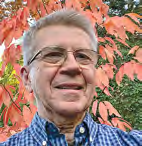2022 Convention – Speakers
Gesneriads In the Pacific Gateway
July 4 to July 9, 2022
 Sadie Barber – “Gesneriaceae at one of the world’s oldest botanical gardens”
Sadie Barber – “Gesneriaceae at one of the world’s oldest botanical gardens”
2020 was a big year for the Royal Botanic Garden Edinburgh (RBGE) as it celebrated its 350th birthday. RBGE is a world leader in Gesneriaceae research dating back to the days of legendary duo Bill Burtt and Olive Hilliard, authors of almost 400 gesneriad species and several books including “Streptocarpus: An African Plant Study” (1971).
Cutting-edge research continues at the Garden to this day; there are always new techniques to try, especially with the rapid evolution of genetic studies. Sadie, Research Collections and Project Manager, will look back at the history of growing and studying gesneriads at the institution and how the work of the horticulturists and scientists have contributed to the understanding of this special group of plants.
The Garden has particular strength in growing Old World Gesneriaceae. Currently the research focuses primarily on Streptocarpus. Recently there have also been studies at RBGE into the genera Oreocharis, Paraboea, Cyrtandra, and Aechynanthus. Sadie will show the breadth of the collections at RBGE, including species new to science that have been described for the first time from cultivated material grown by horticulturists in Edinburgh.
Sadie Barber has been working at RBGE for 15 years, 12 years of which was as a horticulturist specializing in Gesneriaceae. Before entering the world of horticulture, Sadie enjoyed a variety of adventures including working as a photographer, chef, and training to be a safari guide while living in Zambia. Her time in horticulture has also been an adventure with travels to the Middle East, US, Southern Africa, and South East Asia for horticulture training and field collecting.
 Stephen Maciejewski – “Plant Hunting in Vietnam”
Stephen Maciejewski – “Plant Hunting in Vietnam”
Stephen will take us on another expedition to explore the wild side of Vietnam, a country that offers a treasure trove of opportunities for finding plants new to science. If Covid has kept you homebound, you will especially enjoy this escape into the wilderness of Southeast Asia.
This was Stephen’s third expedition to Vietnam. It was also the longest – a total of 19 days just in Vietnam and another 15 days in China. It turned out to be the most challenging, too, dealing with leeches, swollen streams, near-vertical, ladder-like climbs and descends, and a hospital visit. The rewards were worth it. Fifty species of gesneriads were found, with ten species new to science and fifteen species new for Vietnam. You will see gesneriads no one has ever seen before!
So join Stephen, along with Do Van Truong from Hanoi, Vietnam (botanist at the National Museum of Nature in Hanoi), Wen Fang (botanist and taxonomist at the Gesneriad Conservation Center in Guilin, China), Zi-Bing Xin (researcher at the GCCC), Wen-Ke Dong from Beijing, China (horticulturist and Cultivar Registrar for the American Begonia Society), and a host of new-found friends on this unforgettable expedition.
Stephen is married to the Green World. This will be his 25th year exhibiting at the Philadelphia Flower Show. He is President of the Liberty Bell Chapter and co-chair of both the Student Convention Grant and the Conservation Committees of The Gesneriad Society. Stephen is Vice President of the American Begonia Society (ABS) and co-chair of the ABS Conservation Committee. He is also the co-founder of the Gesneriad Conservation Center of China (GCCC) and has co-led five group trips to China to share his enthusiasm for exploring and finding new gesneriads and begonias and to build support for their conservation.
 David Zaitlin – “The Names of Plants”
David Zaitlin – “The Names of Plants”
Taxonomy is important, because this is how we know our plants. The last decade has seen many fundamental changes in Gesneriaceae classification. David will give a presentation describing how plants are named, the unique features of plant names, and how and why plant names can (and do) change.
Dave Zaitlin, PhD, has been a member of The Gesneriad Society for at least 35 years and is also a lifetime member of the Gesneriad Hybridizers Association. His main interest in gesneriads is the genus Sinningia, in particular the wild forms of S. speciosa. He has written many articles for our journal over the years, several of which described field trips to Brazil.
David’s Sinningia journey began in 1974 with the purchase of a miniature sinningia from a small plant shop in Ithaca, NY. This plant had the cryptic name ‘N20’, and it may have been a reject from a local person’s plant breeding program. Since that time David has grown many thousands of plants, mostly from seed, and made many, many crosses. By far his most widely grown and popular hybrid is Sinningia ‘Deep Purple Dreaming’, a cross between the micro-miniature species Sinningia concinna and the tall growing species S. sellovii. In his sinningia breeding program, David introduced the gene for red corolla color from the S. speciosa cultivar ‘Empress’ into a wild form with dark leaves and bi-colored white and purple flowers. A cultivar that resulted from this, S. speciosa ‘Marjorie Jean’, was shown at the Gesneriad Society Convention in Cincinnati, OH in 2019.
David was educated at the University of Arizona and Cornell University, and holds a doctoral degree in biochemistry from the University of California, Davis. He has worked in both private companies and in academic settings as a plant molecular biologist/geneticist since finishing post-doctoral training at Harvard University in 1988. He is currently a scientist and Associate Director of the Kentucky Tobacco Research & Development Center at the University of Kentucky, a position he has held for 20 years. Starting nearly 15 years ago, he was very fortunate to be able to merge his plant hobby with his professional interests and perform research in S. speciosa. He has several publications in this area, and was the first to quantify genome sizes in a group of 10 Sinningia species. He showed that S. speciosa has a relatively small genome for a plant, and that the genome size in this species can vary by ~20%, depending on the population from which the plants originated.
 Laura Clavijo – “Geographic patterns in the evolution of the genus Drymonia”
Laura Clavijo – “Geographic patterns in the evolution of the genus Drymonia”
Understanding the patterns and processes that have shaped the current distribution of biodiversity in the Neotropics is a significant focus in biological research. Extensive fieldwork, the study of herbarium collections, and robust molecular phylogenetic hypotheses are fundamental to infer these patterns and address hypotheses of range evolution. Drymonia, the third largest genus of Neotropical Gesneriaceae, ranges from southern Mexico to Bolivia, including the Caribbean, northern Brazil, and Guyana. It has an Andean-centered distribution pattern, with the highest diversity found in cloud forests of southern Central America and northern South America. Drymonia encompasses remarkable variation in floral and fruit shapes and colors and growth habit traits. Laura’s research has explored several aspects of the diversity, systematics, and evolutionary biology of the genus Drymonia.
Laura Clavijo, PhD, is a Colombian botanist with a biology degree from Universidad Nacional de Colombia. She is Assistant Professor at the Instituto de Ciencias Naturales of the Universidad Nacional de Colombia and curator of the National Herbarium of Colombia. Laura earned her PhD in Biological Sciences from the University of Alabama in 2016, where she studied under Dr. John L. Clark. Laura has studied gesneriads for almost two decades, mainly in Colombia, and has explored other neotropical countries such as Ecuador and Peru. She has discovered and described several new species to science, mainly in the genus Drymonia. In 2016, in collaboration with Drs. John L. Clark and Larry E. Skog, Laura composed the species list for the “Catalogue of Plants and Lichens of Colombia.”
Laura’s research has focused on Drymonia in the past decade. Her doctoral dissertation focused on the systematics and evolution of the genus, so her presentation will cover some aspects of this research. Laura started studying Drymonia because it is a fascinating genus due to its morphological variation and diverse growth habits, such as vines, epiphytes, and nomadic lianas. Floral evolution in the genus is also intriguing since it results from intricate interactions with pollinators like hummingbirds and bees. Laura has presented at previous conventions talking about the diversity and morphology of Drymonia, its patterns of floral evolution, and the diversity and conservation of Gesneriaceae in Colombia. In 2022, Laura will show the geographic context in which Drymonia has evolved, highlighting the importance of the Andes uplift for Gesneriaceae diversification in the Neotropics. Laura continues describing the fantastic diversity of Gesneriaceae of her home country in collaboration with students and local and foreign experts. She is starting new projects on the pollination biology of Drymonia.
